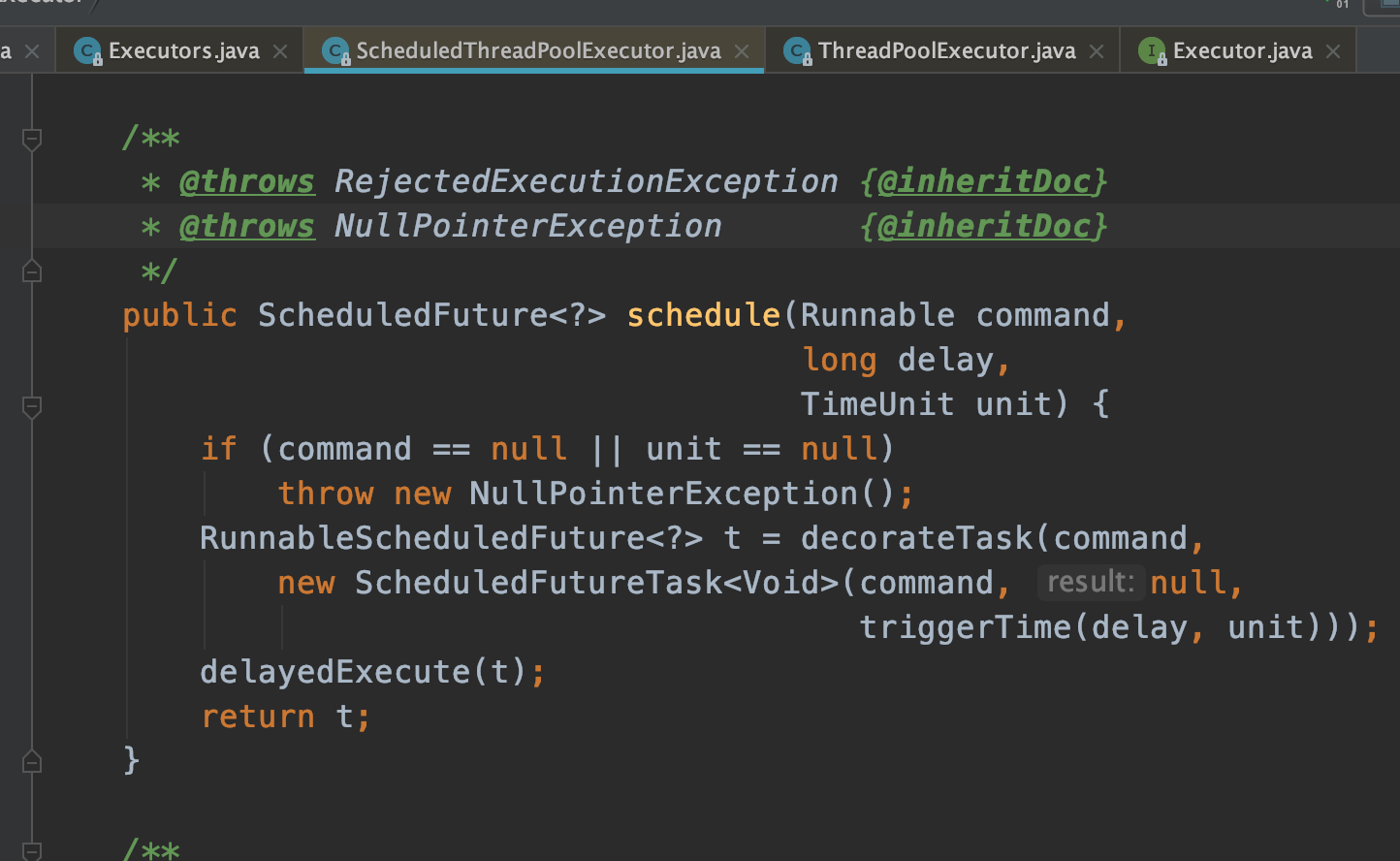java线程池笔记
1、线程池继承图
classDiagram
ThreadPoolExecutor <|-- AbstractExecutorService
AbstractExecutorService <|-- ExecutorService
ExecutorService <|-- Executor
<<interface>> Executor
<<interface>> ExecutorService
<<abstract>> AbstractExecutorService
2、创建线程池
构造函数-核心参数
int corePoolSize 核心线程数
int maximumPoolSize 最大线程数
long keepAliveTime 空闲线程保存时间
TimeUnit unit 空闲线程保存时间单位
BlockingQueue
核心参数
//ctl原子类高三位代表线程池状态,低29位维护线程池中线程数量
private final AtomicInteger ctl = new AtomicInteger(ctlOf(RUNNING, 0));
//COUNT_BITS:29
//CAPACITY:11111111111111111111111111111
//Integer.SIZE=32,也就是29位代表线程数量
private static final int COUNT_BITS = Integer.SIZE - 3;
private static final int CAPACITY = (1 << COUNT_BITS) - 1;
//线程池的五种状态 线程池一般也是按照下面状态流转的
//RUNNING:111 线程池正在运行中,处理任务并接收任务
//SHUTDOWN:000 处理任务但是不再接收任务
//STOP:001 不接收任务,且不再处理任务并且会中断正在执行的任务
//TIDYING:010 线程池中所有任务都接收,worker为0,并且会调用terminated方法
//TERMINATED:100 terminated方法调用之后会变成此状态
private static final int RUNNING = -1 << COUNT_BITS;
private static final int SHUTDOWN = 0 << COUNT_BITS;
private static final int STOP = 1 << COUNT_BITS;
private static final int TIDYING = 2 << COUNT_BITS;
private static final int TERMINATED = 3 << COUNT_BITS;
// 两个方法分别是获取线程池状态(ctl高三位),工作的线程个数(ctl低29位)
private static int runStateOf(int c) { return c & ~CAPACITY; }
private static int workerCountOf(int c) { return c & CAPACITY; }
//参数rs表示runState,参数wc表示workerCount,即根据runState和workerCount打包合并成ctl
private static int ctlOf(int rs, int wc) { return rs | wc; }
核心执行方法:
/**
* Executes the given task sometime in the future. The task
* may execute in a new thread or in an existing pooled thread.
* 在未来的某个时刻执行给定的任务。这个任务用一个新线程执行,或者用一个线程池中已经存在的线程执行
*
* If the task cannot be submitted for execution, either because this
* executor has been shutdown or because its capacity has been reached,
* the task is handled by the current {@code RejectedExecutionHandler}.
* 如果任务无法被提交执行,要么是因为这个Executor已经被shutdown关闭,要么是已经达到其容量上限,任务会被当前的RejectedExecutionHandler处理
*
* @param command the task to execute
* @throws RejectedExecutionException at discretion of
* {@code RejectedExecutionHandler}, if the task
* cannot be accepted for execution RejectedExecutionException是一个RuntimeException
* @throws NullPointerException if {@code command} is null
*/
public void execute(Runnable command) {
if (command == null)
throw new NullPointerException();
/*
* Proceed in 3 steps:
*
* 1. If fewer than corePoolSize threads are running, try to
* start a new thread with the given command as its first
* task. The call to addWorker atomically checks runState and
* workerCount, and so prevents false alarms that would add
* threads when it shouldn't, by returning false.
* 如果运行的线程少于corePoolSize,尝试开启一个新线程去运行command,command作为这个线程的第一个任务
*
* 2. If a task can be successfully queued, then we still need
* to double-check whether we should have added a thread
* (because existing ones died since last checking) or that
* the pool shut down since entry into this method. So we
* recheck state and if necessary roll back the enqueuing if
* stopped, or start a new thread if there are none.
* 如果任务成功放入队列,我们仍需要一个双重校验去确认是否应该新建一个线程(因为可能存在有些线程在我们上次检查后死了) 或者 从我们进入这个方法后,pool被关闭了
* 所以我们需要再次检查state,如果线程池停止了需要回滚入队列,如果池中没有线程了,新开启 一个线程
*
* 3. If we cannot queue task, then we try to add a new
* thread. If it fails, we know we are shut down or saturated
* and so reject the task.
* 如果无法将任务入队列(可能队列满了),需要新开区一个线程(自己:往maxPoolSize发展)
* 如果失败了,说明线程池shutdown 或者 饱和了,所以我们拒绝任务
*/
int c = ctl.get();
/**
* 1、如果当前线程数少于corePoolSize(可能是由于addWorker()操作已经包含对线程池状态的判断,如此处没加,而入workQueue前加了)
*/
if (workerCountOf(c) < corePoolSize) {
//addWorker()成功,返回
if (addWorker(command, true))
return;
/**
* 没有成功addWorker(),再次获取c(凡是需要再次用ctl做判断时,都会再次调用ctl.get())
* 失败的原因可能是:
* 1、线程池已经shutdown,shutdown的线程池不再接收新任务
* 2、workerCountOf(c) < corePoolSize 判断后,由于并发,别的线程先创建了worker线程,导致workerCount>=corePoolSize
*/
c = ctl.get();
}
/**
* 2、如果线程池RUNNING状态,且入队列成功
*/
if (isRunning(c) && workQueue.offer(command)) {
int recheck = ctl.get();//再次校验位
/**
* 再次校验放入workerQueue中的任务是否能被执行
* 1、如果线程池不是运行状态了,应该拒绝添加新任务,从workQueue中删除任务
* 2、如果线程池是运行状态,或者从workQueue中删除任务失败(刚好有一个线程执行完毕,并消耗了这个任务),确保还有线程执行任务(只要有一个就够了)
*/
//如果再次校验过程中,线程池不是RUNNING状态,并且remove(command)--workQueue.remove()成功,拒绝当前command
if (! isRunning(recheck) && remove(command))
reject(command);
//如果当前worker数量为0,通过addWorker(null, false)创建一个线程,其任务为null
//为什么只检查运行的worker数量是不是0呢?? 为什么不和corePoolSize比较呢??
//只保证有一个worker线程可以从queue中获取任务执行就行了??
//因为只要还有活动的worker线程,就可以消费workerQueue中的任务
else if (workerCountOf(recheck) == 0)
addWorker(null, false); //第一个参数为null,说明只为新建一个worker线程,没有指定firstTask
//第二个参数为true代表占用corePoolSize,false占用maxPoolSize
}
/**
* 3、如果线程池不是running状态 或者 无法入队列
* 尝试开启新线程,扩容至maxPoolSize,如果addWork(command, false)失败了,拒绝当前command
*/
else if (!addWorker(command, false))
reject(command);
}
3、基本使用
Executors提供了四种常见的线程池
newFixedThreadPool 固定线程池,核心线程池个数固定,采用LinkedBlockingQueue作为等待队列,LinkedBlockingQueue基本上算是无限的,也就是说任务进来到达核心线程个数上线之后,就一直等待。
newSingleThreadExecutor 单线程线程池,相当于newFixedThreadPool 设置的核心线程数为1,保证只有一个线程在执行任务,其余的都在等待,任务执行完成后继续下一个
newCachedThreadPool 可缓存线程池 核心线程数为9,最大线程数为Integer.MAX_VALUE,空闲时间为60s,等待队列使用了SynchronousQueue,SynchronousQueue是一种无缓冲的等待队列,也就是说真正执行的线程数可以动态伸缩,比较适合任务多,执行快的。
newScheduledThreadPool是可调度的线程池,可以在设定的时间内执行,其实现方式与上面三个是不一样的,实现类为ScheduledThreadPoolExecutor。

参考博客